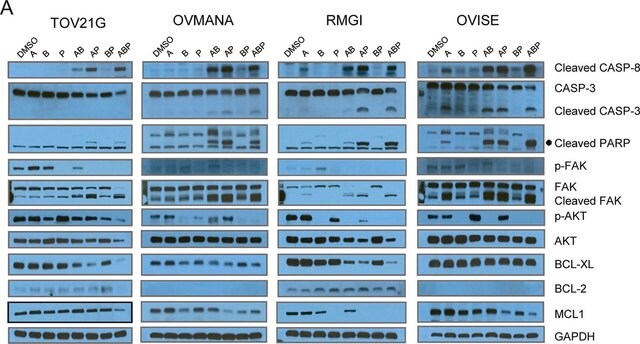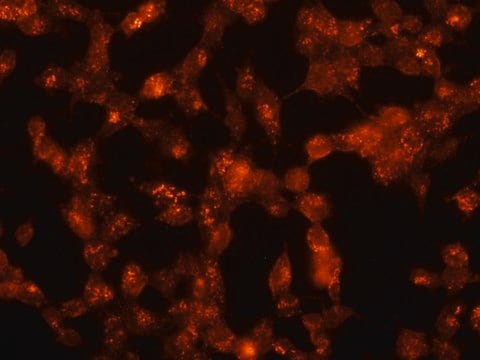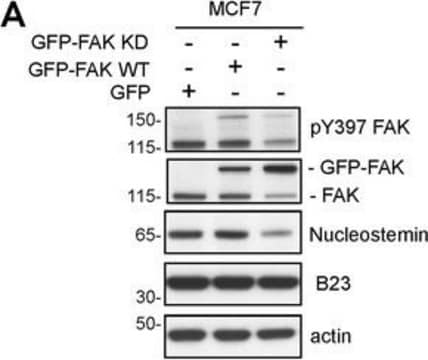推荐产品
生物源
mouse
品質等級
抗體表格
purified antibody
抗體產品種類
primary antibodies
無性繁殖
13G8, monoclonal
物種活性
mouse, human
製造商/商標名
Chemicon®
Upstate®
技術
ELISA: suitable
immunocytochemistry: suitable
western blot: suitable
同型
IgG1
UniProt登錄號
運輸包裝
wet ice
目標翻譯後修改
unmodified
基因資訊
human ... EGFR(1956)
mouse ... Egfr(13649)
特異性
Recognizes C-terminus domain of EGF receptor (aa1165-1186)
免疫原
KLH-conjugated synthetic peptide encompassing the surrounding amino acids of the C terminus in human EGFR
應用
Anti-EGFR (C-terminus) Antibody, clone 13G8 detects level of EGFR (C-terminus) & has been published & validated for use in ELISA, IC & WB.
Research Category
Signaling
Signaling
Research Sub Category
Growth Factors & Receptors
Growth Factors & Receptors
品質
Routinely evaluated by immunoblot.
標靶描述
180 kDa
聯結
Replaces: 04-337; 04-338
外觀
Subsequent thiophilic adsorption and size exclusion chromatography
100 µg of purified mouse monoclonal IgG lyophilized in PBS containing 0.09% sodium azide, PEG, and sucrose
Format: Purified
儲存和穩定性
2 years at -20°C from date of shipment
分析報告
Control
Includes EGF treated Hep2G lysate as a positive control
Includes EGF treated Hep2G lysate as a positive control
法律資訊
CHEMICON is a registered trademark of Merck KGaA, Darmstadt, Germany
UPSTATE is a registered trademark of Merck KGaA, Darmstadt, Germany
免責聲明
Unless otherwise stated in our catalog or other company documentation accompanying the product(s), our products are intended for research use only and are not to be used for any other purpose, which includes but is not limited to, unauthorized commercial uses, in vitro diagnostic uses, ex vivo or in vivo therapeutic uses or any type of consumption or application to humans or animals.
Not finding the right product?
Try our 产品选型工具.
儲存類別代碼
10 - Combustible liquids
Katsuyuki Hotta et al.
Oncology reports, 17(2), 313-317 (2007-01-05)
Despite its tremendous antitumor effect in a subset of patients with non-small cell lung cancer (NSCLC), the exact mechanism of gefitinib-induced cell death has not been fully determined. In this study, forms of cell death in various NSCLC cell lines
Xiaozhu Zhang et al.
Journal of medical genetics, 44(3), 166-172 (2006-12-13)
Frequent overexpression of epidermal growth factor receptor (EGFR) in non-small-cell lung cancer (NSCLC) makes EGFR a new therapeutic target. Two specific EGFR tyrosine kinase inhibitors, gefitinib (ZD1839, Iressa) and erlotinib (OSI-774, Tarceva), have been developed and approved by the US
Francesca Walker et al.
Experimental cell research, 313(3), 511-526 (2006-12-13)
The site of action of growth factors on mammalian cell cycle has been assigned to the boundary between the G1 and S phases. We show here that Epidermal Growth Factor (EGF) is also required for mitosis. BaF/3 cells expressing the
David W M Tan et al.
Development (Cambridge, England), 140(7), 1433-1444 (2013-03-14)
Human epidermal stem cells express high levels of β1 integrins, delta-like 1 (DLL1) and the EGFR antagonist LRIG1. However, there is cell-to-cell variation in the relative abundance of DLL1 and LRIG1 mRNA transcripts. Single-cell global gene expression profiling showed that
An FGFR1-SPRY2 Signaling Axis Limits Basal Cell Proliferation in the Steady-State Airway Epithelium.
Gayan I Balasooriya et al.
Developmental cell, 37(1), 85-97 (2016-04-06)
The steady-state airway epithelium has a low rate of stem cell turnover but can nevertheless mount a rapid proliferative response following injury. This suggests a mechanism to restrain proliferation at steady state. One such mechanism has been identified in skeletal
我们的科学家团队拥有各种研究领域经验,包括生命科学、材料科学、化学合成、色谱、分析及许多其他领域.
联系技术服务部门








